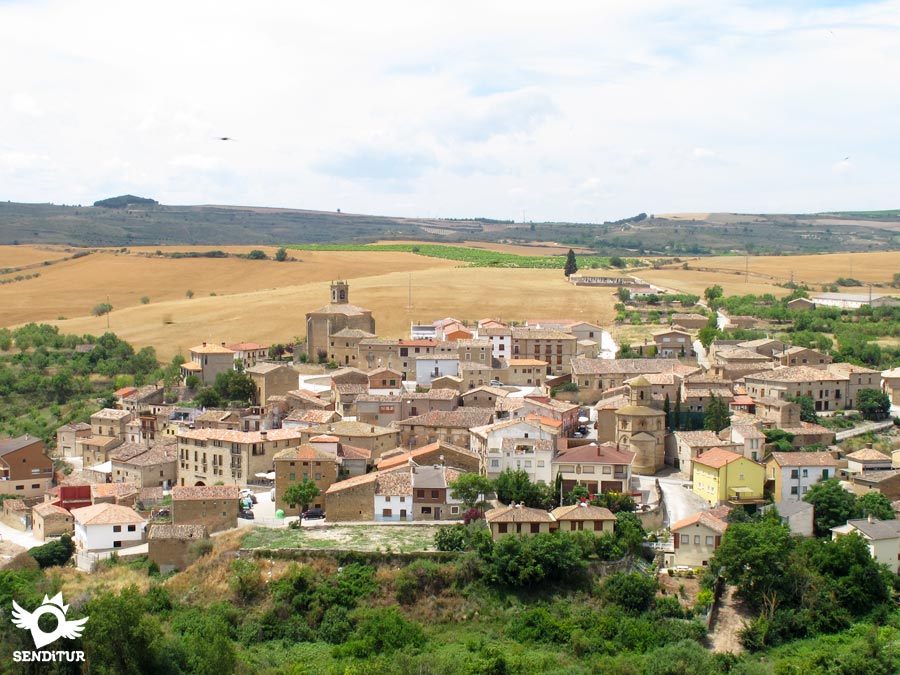Also known as Torres de Sansol, it is located on a hilltop next to the hill of Sansol, in a picturesque setting surrounded by fields presided over by the Sierra de Codés. Although the whole area was intensely Romanized, few vestiges remain of it. According to chronicles, the town already existed before the Muslim invasion and was reconquered after Monjardín. Being already Christian, it is known that it had a monastery that in 1109 was donated to the one of Irache. Pope Alexander III, in 1172, took under his protection the monastery of Irache and its abbot Viviano, confirming all their advantages and possessions, among which is expressly mentioned the Torres "Turres" with all their belongings.

Being one of the five towns of Los Arcos, Torres del Río, due to disputes between Henry IV of Castile and John II of Aragon, was annexed to Castile from 1463 to 1753, the year in which King Ferdinand VI returned them to Navarre. Although during these years it continued to be governed by Navarrese law and remained economically immersed in Navarre. It has been historically recorded that people from the town together with other guerrillas from neighbouring towns and commanded by General Mina clashed with French troops during the War of Independence.
Torres del Río is a charming village with an irregular layout due to the slopes of the hill where it is situated, and narrow, steep streets in which we find mansions with coats of arms from the 17th and 18th centuries, protected by the parish church called San Andrés, in honour of its patron saint, which is a Gothic-Renaissance masonry work, built at the beginning of the 17th century on top of another previous church, and located at the top of the village.

In the lower part of the village, sheltered from its houses, is the church of the Holy Sepulchre, an architectural jewel of the Romanesque of the twelfth century, which by its octagonal plan reminds the basilica of Jerusalem. It has a unique star vault of Caliphate origin. The only image inside, which serves as a brooch for such beauty, is a Romanesque carving of the Crucified, with a royal crown and four nails.
The patron saint fiestas in honour of the Vera Cruz are held on the second weekend of September. On November 30 they honor their Patron Saint Andres.
In the church of the Holy Sepulchre is the tower or lantern, identical in shape to the church, but in small and simplified form. In each of the sides of this tower corresponding to the cardinal points a window is opened. Its function seems to be to serve as a guide for pilgrims, as a fire was kept lit inside so that it could be seen in the distance. On the other hand and due to the centralized and octagonal plan of the church, this one, is considered as Funerary Monument and its tower with its flame would have a symbolic value of purifying fire of souls with a view to the Resurrection as the so called "lanterns of the dead" that abounded in the medieval European cemeteries.

The church of the Holy Sepulchre is attributed its construction and use to the Templars, but there are no data to prove it, others give its origin to the Order of the Holy Sepulchre, but what is certain is that it represents an almost unique spatial experience in the Navarrese Romanesque.
Legend has it that a hungry and tired pilgrim, before entering Torres del Río ran into a stranger, who by his attire seemed to be rich and who offered him the possibility of being as rich as he was, asked him to give him his body and soul at the moment of his death. The pilgrim replied, "The body belongs to the soul, and this belongs to God, so I cannot give what is not mine. Then, the stranger who was none other than the devil, pounced against him, but this rosemary, taking a leap, projected his shadow on the attacker who, getting into a fight with her, disappeared and took her away. The pilgrim lost his shadow but saved his soul.
You can get to Torres del Río via the NA-1110, from what used to be the national road between Viana and Los Arcos. You can also get to it via the NA-6310, which joins it to the Motorway of the Way, A-12, or via the NA-7200 from nearby Espronceda.
Torres del Río has a bus stop that covers the Logroño-Pamplona/Iruña line.
SENDITUR is not responsible for any variation in the information described, as well as for the misuse of its guides and recommends that everyone be responsible and prudent in carrying out the activity. Likewise, we invite you to document yourself with books and specialized guides to complement the information described. From the commitment of SENDITUR with Nature and the respect to the balance of the environment, SENDITUR urges you to travel in a responsible way, with low environmental impact and respecting at all times the Natural, Cultural and Social environment wherever you go. For any suggestion, SENDITUR invites you to send an email to .
Continue watching …